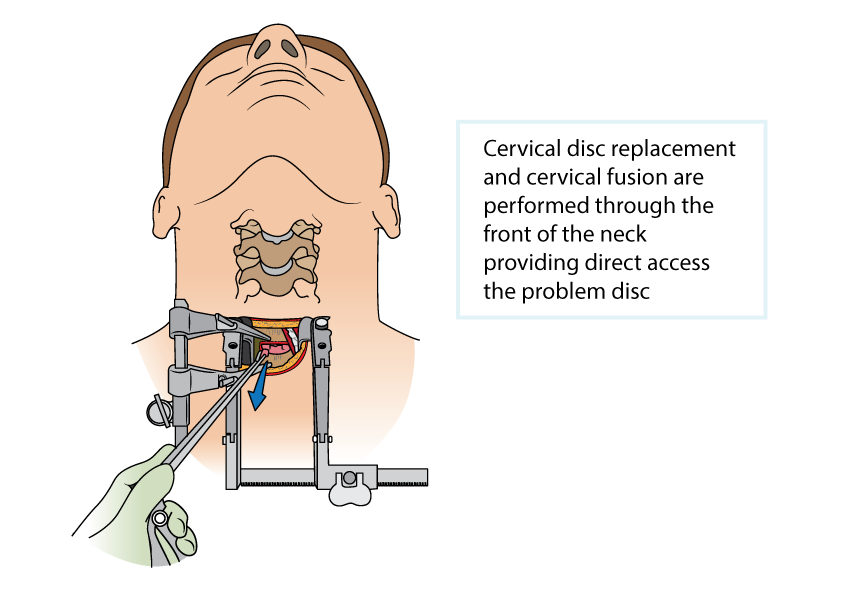Cervical Disc Replacement
Cervical artificial disc surgery is a type of joint replacement procedure, or arthroplasty, which involves inserting a cervical artificial disc into the intervertebral space after a natural cervical disc has been removed. A cervical artificial disc is a prosthetic device designed to maintain motion in the treated vertebral segment. A cervical artificial disc essentially functions like a joint, allowing for flexion, extension, side bending and rotation. Fun Fact - Dr. Michael Casnellie performed the first cervical disc arthroplasty in Kentucky.
We offer same-week appointments by our highly trained spine and pain management teams to diagnose painful spine injuries and conditions where we can discuss your non-surgical and surgical treatment options, including cervical disc replacement.
Our Spine Team
Michael Casnellie, MD
Orthopedic Spine Surgery
Curriculum Vitae
David McConda, MD
Orthopedic Spine Surgery
Curriculum Vitae
Jaideep Chunduri, MD
Orthopedic Spine Surgeon
Curriculum Vitae
Steven Ganzel, DO
PM&R and Pain Management
David Koonce, DNP
Orthopedic D.N.P.
Michael Gilbert, PA-C
Orthopedic P.A.
Candidates for Disc Arthroplasty (Replacement)
When non-surgical therapies fail to provide relief from your cervical symptoms, your doctor may recommend surgery. The goal of cervical artificial disc surgery is to remove all or part of a damaged cervical disc (discectomy), relieve pressure on the nerves and/or spinal cord (decompression) and to restore spinal stability and alignment after the disc has been removed.
Cervical disc arthroplasty recreates the natural spinal structure, relieving pain while preserving flexibility. Cervical arthroplasty typically only requires one, very small, incision at the front of the neck.
Our Spine team may recommend a cervical artificial disc replacement surgery for you if:
You have been diagnosed with cervical radiculopathy, myelopathy or both with the presence of disc herniation and/or bone spurs
Your symptoms did not improve after conservative treatment measures, such as exercise, pain relievers, physical therapy and/or chiropractic care
You require treatment at only one cervical level
You are at least 18 years of age with skeletal maturity
Are not pregnant or nursing at the time of surgery
Procedure Details
This is a very common procedure. The procedure is performed under general anesthesia. Through a small incision made near the front of your neck (a surgical approach called the anterior approach) your surgeon will:
Gently pull aside the soft tissues – skin, fat and muscle – as well as the trachea, or windpipe, to access the cervical spine
Expose the area where disc fragments and/or bone spurs are pressing against the neural structures (nerve roots and/or spinal cord)
Remove the disc and bone material from around the neural structures to give them more space (discectomy and decompression)
Insert and secure the artificial disc into the intervertebral space, using specialized instruments
Ease the soft tissues of the neck and other structures back into place and
Close the incision
Recovery
Disc replacement surgery is very well tolerated by most patients and relieves the symptoms of nerve compression in over 90% of patients. Many patients are able to go home the same day or the next day following surgery. It is not unusual to have some the following symptoms after the surgery which generally improve over 1 - 4 weeks.
neck pain
pain between the shoulder blades (intrascapular pain)
pins and needles, or tingling, in the arm or hand
a change in the character of your voice - due to stretch of the nerve that goes to your voice box
sore throat
difficulty swallowing
These symptoms are generally easily controlled with simple analgesia. Patients are asked to avoid heavy lifting, contact sports and excessive physical exertion for 6 - 12 weeks after surgery. Most patients can resume driving after 2-3 weeks. It is not routine for patients to have to wear a cervical collar after surgery.
Your spine surgeon will have a specific post-operative recovery plan to help you return to your normal activity level as soon as possible. Your length of stay in the hospital will depend on your treatment and physical condition. You typically will be up and walking by the end of the first day after the surgery. Your return to work will depend on how well your body is healing and the level of activity to which you want to return.










